Freezer-Burned: Tales of Interior Alaska
Posted February 6, 2021 at 5:00 am by Hayley Day
“Freezer-Burned: Tales of Interior Alaska” is a regular column on the San Juan Update written by Steve Ulvi.
Forever More
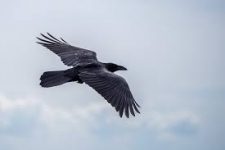 With the blush of light closing out a long sub-arctic night, among the first daytime creatures to engage in food-seeking are the clans of Common Ravens, who launch impatiently from their heavily branched roosts in towering spruce.
With the blush of light closing out a long sub-arctic night, among the first daytime creatures to engage in food-seeking are the clans of Common Ravens, who launch impatiently from their heavily branched roosts in towering spruce.
They coordinate their foraging with varied calls, often cavorting in pairs as they radiate from the heavy canopy. Swishing, pumping wing beats, like swimming in thick air, their emphatic kraak-kraak calls are absorbed by forest trunks and moss cover, echoed by rock faces.
Highly adaptable, they succeed from desert to tundra biomes on all continents.
They are seen high on Denali and in the Himalayas scrounging climbing camps. Beyond the magnet of community garbage dumps (and highly unnatural population densities), northern Common Ravens spread out to scan lake shores and stream courses for the leavings of determined predation or weakened demise during the protracted night. They roost close, silent in the dark, for they know and fear the “tigers of the night”: ferocious Great Horned Owls, silent in flight with acute night vision, razor talons of cable-steel grip, the apex winged predator of the wintry boreal forest.
Along the course of a small creek, similar to scores of others within patrol range, early light reveals fox tracks as dainty lines of prints between diggings along drift woodpiles. Lynx prints stitch the edges of a bent slough, willows bent down with accumulated snowfall. Scattered tufts of grey hair and blood spots record a nervous snowshoe hare taken hard from the air; impact crater, outstretched wing prints, drag marks into the air away from the willow edge.
Bright white ptarmigan flush in low, rapid flight, careening into the next river bar where they cluck and settle to jump up to nibble willow-tips. Open water, rushing in blackness, fogs and crystallizes on acres of still, red-stemmed brush. The only other starkly black things in that subarctic world dip and swerve and call to one another overhead. Searching, a pair of ravens seems unfocused, without a care, but are certainly hunger focused. Another 35 below zero dawn, pink-orange beneath cobalt blue in the southeast sky, with scant few hours to forage. They may fly many circuits, then return to hunker down for another 18 hours of darkness.
For passionate observers of nature, birds occupy center stage as a common and noticeable presence in our daily lives. Wherever you go there they are. Human landscapes often create a more diverse mosaic of habitat, fewer natural predators and along with feed stations, readily increase the richness and diversity of bird life. Many of us, in wide-eyed youth, had our imaginations opened to the endless wonders of the natural community of life by the common birds around our homes. Only in that familiarity with common scenes do the uncommon events begin to catch your attention as a nature observer. Some of us gave in to more primordial curiosity, a complex mix of urges, and could not simply observe.
As young kids we had permission to shoot raucous “blue jays” (actually California Scrub Jays), from our oaks with BB guns, wrongly assured that we were doing nature a favor because they ravaged other bird’s eggs and nestlings. Jays and their cousins are easily perceived as obnoxious raiders. Looking closely at dead birds in hand, jays as well as smaller victims, slowly opened my minds-eye to the astounding perfection of birds. Our aviary of parakeets, banty chickens scratching in the yard, and later while raising homing pigeons in a cast-off piano crate, colored my interests. But those scrub jays, along with my efforts trying to trap Red Tailed hawks, and a captured Kestrel stoked my curiosity for crow and raptor groups.
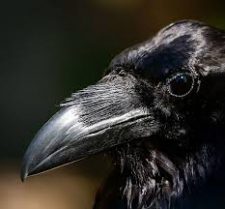 Birds thrive in every habitat on earth. It is hard to imagine a place, beyond sea depths or very high elevation, where there are seldom birds of any kind. Even in the frigid depth of severe winters in the interior of Alaska, an endless mosaic of taiga and tundra far from the sea, there are about 25 species of resident birds. From the tiny puffs of Boreal Chickadees to the towering Great Gray Owl, they exhibit elegant physiological adaptations (for no birds hibernate) that enable them to thrive in a winter dominant, hard-frozen landscape.
Birds thrive in every habitat on earth. It is hard to imagine a place, beyond sea depths or very high elevation, where there are seldom birds of any kind. Even in the frigid depth of severe winters in the interior of Alaska, an endless mosaic of taiga and tundra far from the sea, there are about 25 species of resident birds. From the tiny puffs of Boreal Chickadees to the towering Great Gray Owl, they exhibit elegant physiological adaptations (for no birds hibernate) that enable them to thrive in a winter dominant, hard-frozen landscape.
Far more intelligent than dogs, able to imitate the calls of other creatures, playful and social, these black characters of the boreal forest launch to search with keen eyes, a fine sense of smell, and an uncanny recognition of small things out of place in the ever-changing natural scenes around them. We had a local clan (I refuse to call a group of ravens as an “unkindness”), co-inhabitants really, around our rustic homestead at Windy Corner on the Yukon River.
They joined the small local wolf pack (literally a ‘borderline’ pack), that was often food stressed to excavate fish heads and guts from our garden beds in hard times. The clan always posted a lookout to warn of our approach from the cabin as they investigated our skiff, fish racks and beach area again. Better hope that strong winds had not un-tarped a pile of bagged dog food or some such. They seemed to recognize a rifle in hand, especially after I gave in to frustration after days of drying fish being pulled to the ground, to shoot one and hang it in warning. That crude solution worked for a while but I always regretted it and never harmed another raven. They often landed just beyond the reach of our chained sled dogs to taunt them while finding food bits or the end results of canine digestion.
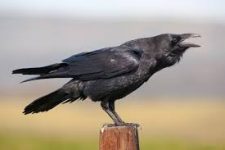 Surely, our ultimate fascination with birds is that most possess the astonishing freedom of flight, perhaps the most deeply ingrained envy of the human psyche. I have dreamed hundreds of times since childhood of being able to concentrate, pump my arms and slowly rise twenty to thirty feet into the air to cruise about, like pulling oneself up in the water from the bottom of a pool. If I ever stumble across a dusty old amphora, uncork it and have a genie emerge granting 3 wishes (I am channeling I Dream of Jeannie here…): flight would likely be one wish.
Surely, our ultimate fascination with birds is that most possess the astonishing freedom of flight, perhaps the most deeply ingrained envy of the human psyche. I have dreamed hundreds of times since childhood of being able to concentrate, pump my arms and slowly rise twenty to thirty feet into the air to cruise about, like pulling oneself up in the water from the bottom of a pool. If I ever stumble across a dusty old amphora, uncork it and have a genie emerge granting 3 wishes (I am channeling I Dream of Jeannie here…): flight would likely be one wish.
The physical attributes and flight capability of thousands of species of birds varies depending upon their food/prey preferences and the challenges in obtaining them. Each has been ruthlessly shaped by the unforgiving crucible of natural selection leading to passing on DNA and adaptive physical traits. That continuous whittling of form and function, if it had a perceptible sound, might be a very low frequency thrum beyond our ken.
For birds a main evolutionary branch extends with many limbs into the present; scales to feathers, bone hollowing, stubby forelegs to wings (developed from flailing arms to climb things?), from well before the catastrophic end of the Age of Dinosaurs. When the Chicxulub mega-asteroid slammed into the Yucatan Peninsula about 66 million years ago, the 100 million megaton blast ejected iridium, gypsum and clay into the atmosphere leaving a definitive geologic layer all over the earth (called the K-Pg boundary) and erased about 75% of all life.
Most of the incredible diversity of dinosaur species died out, but creatures that burrowed or could dive underwater (apparently including early duck and chicken types of birds) survived along with a few of the smaller, cold-blooded dinosaur lineages and crocodilians. Among the mammals then, some rat-like burrowers that made it through the blast, evolved into countless arboreal creatures, some then into primates, branching for scores of millions of years, from which one line dropped back down to the savannah 2-3 million years ago, to become our bi-pedal relatives.
Our fuel gulping, noisome metal machines can overcome gravity and sustain flight but are incredibly crude, clumsy and absurdly limited in comparison with phenomenal birds. Of course, modern machines far surpass the fastest bird-probably the Peregrine Falcon in a 200-mph stoop-but otherwise fall woefully short of the mastery and magic of specialized feathers, elegant physiology and incredible eyesight among modern birds.
Ravens seem to be the functional equivalent of an oversized pick-up truck within the spectrum of passerine birds: plain black primer color, Jimmy Durante beak, neither slow nor fast, eat anything and tough as nails. They are also very social, extremely intelligent, masters of mimicry, playful with other species, tool-using, aerial acrobats, cooperative predators and can remember and relocate food bits they have cached or items of interest within a large territory. Up north, the word was that raising one as a pet in the woods was a high maintenance, pesky relationship often regretted. I prefer them wild and wooly. Ravens can live to 15 years or so in the wild, perhaps up to 40 years in captivity.
Ravens are risk-takers, brimming with confidence, the “smartest kids in the class”. They continuously push the envelope of being raven, often at their own peril. I well remember releasing an adult Peregrine Falcon from a Yukon River beach where we had trapped it for banding and blood sampling. A nearby raven decided to chase the agitated raptor as it pumped rapidly above the water, away from us. In a classic aerial dog fight maneuver, the shifty falcon gained enough speed to abruptly veer up to be instantly above and behind the chasing raven. In a blink the falcon folded to thump the raven hard with fisted feet.
As the falcon perched in the closest snag on the far shore, aggressively preening and re-layering feathers disturbed by our handling, the woozy raven was flailing, trying to ‘swim’ from the middle of the huge river toward shore. Likely to become a rinsed meal for a Bald Eagle. Ravens make a regular habit of harassing eagles but once in a while the big birds quickly flip over and seize the cheeky, black pest in clutched talons.
There is, of course, a big pile of raven data; from boring lab time, findings of cognitive testing and extensive behavioral observation available for these high-profile, human-oriented birds. Suffice it to say that the several recognized common raven subspecies are in a league all their own, as the largest birds of the ‘songbird group’, exhibiting cognitive abilities to solve food puzzles (like the great apes and dolphins), learn from observation and employ simple tools.
 Ravens are also among the most symbolic, folklorish and mythologized birds in human history; from the legendary realms of the Norse, Tibetan, Irish and Chinese to many North American indigenous tribes, especially in the North West. The violent religiosity, public executions, bloody wars and plague deaths in Europe created repeated carnage that surely benefited ravens. As a result, these black, guttural scavengers were often believed to be harbingers of doom and restless spirits of the deceased. In contrast, in North American indigenous groups they were, and continue to be, generally respected for perceived spiritual powers and obvious intelligence (exemplified by their roles in creation stories) as well as associations with human death.
Ravens are also among the most symbolic, folklorish and mythologized birds in human history; from the legendary realms of the Norse, Tibetan, Irish and Chinese to many North American indigenous tribes, especially in the North West. The violent religiosity, public executions, bloody wars and plague deaths in Europe created repeated carnage that surely benefited ravens. As a result, these black, guttural scavengers were often believed to be harbingers of doom and restless spirits of the deceased. In contrast, in North American indigenous groups they were, and continue to be, generally respected for perceived spiritual powers and obvious intelligence (exemplified by their roles in creation stories) as well as associations with human death.
I like to imagine ravens joining with humans following herds of Pleistocene megafauna into North America while the vegetated Bering Land Bridge was dry, cold and blustery for thousands of years. I am sure they did. However, genomic studies have found a raven group that must have flown over the ‘bridge’ in a much earlier glacial period, about 1.5 million years ago to eventually thrive in what is now the California region. This is about the same time our own Homo ergaster relatives were in group walkabouts (leaving fossilized tracks showing a non-arboreal big toe), using more advanced tools and controlling fire in what is now Kenya, Africa.
Arriving in Interior Alaska in 1974, we soon discovered and devoured several newish books by Richard Nelson detailing northern Alaska native culture and lifeways. Foremost was a dry, but seminal anthropological study, describing living among the Kutchin Athapaskans who had long inhabited the upper Koyukuk River in the Interior of Alaska. He titled it Make Prayers to the Raven. My beginner’s mind found some handholds in his descriptions, helping me to adapt to the far north, while my interests in Athapaskan culture and ravens around us, were wetted for a lifetime.
One fall afternoon a raven threesome circled over me hunting in upland tundra, leading me to a pair of caribou that were grazing out of sight, behind a small hill. They were rewarded with gut piles as they hoped to be. They called in the rest of the clan from a distance to obtain strength in numbers. Ravens also frequented the sandy riverine cliffs where in the spring Bank Swallows carved out nests by the hundreds. Collapsing sand tumbled eggs and tiny chicks down to the bottom to be foraged. Ravens also momentarily perched, wings flapping to reach in to pluck young out of the nest hole. I saw three ravens disable a molting and flightless Brant by persistently pecking at its eyes. Knowledgeable people say the same about freshly birthed caribou calves.
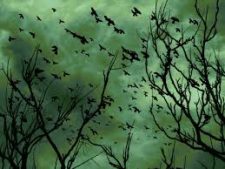 Later, when we moved to Fairbanks, I was exposed to the very large flocks of urban ravens around the sprawling town. “Hitchcockian” flocks flew from scores of conifer roosts to check every dumpster, aggressively expose garbage or edibles in the beds of pickups and gather at roadkill sites. For the heck of it some collected golf balls from the fairways and driving range at the course to pile them in the woods. One especially troublesome bird became expert at stealing windshield wipers from vehicles in my office parking lot. In our woodsy enclave just beyond the University, we were wowed to regularly see a rare, grey raven born into the neighborhood clan.
Later, when we moved to Fairbanks, I was exposed to the very large flocks of urban ravens around the sprawling town. “Hitchcockian” flocks flew from scores of conifer roosts to check every dumpster, aggressively expose garbage or edibles in the beds of pickups and gather at roadkill sites. For the heck of it some collected golf balls from the fairways and driving range at the course to pile them in the woods. One especially troublesome bird became expert at stealing windshield wipers from vehicles in my office parking lot. In our woodsy enclave just beyond the University, we were wowed to regularly see a rare, grey raven born into the neighborhood clan.
Sadly, but entirely predictably, raven populations in the interior west near cities and open landfills, have exploded in recent decades and are now being poisoned or harassed with high-tech gizmos for a variety of “conflicts” with urbanity and preying on endangered species undergoing recovery efforts like Desert Tortoises and Greater Sage Grouse.
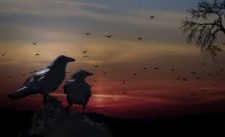 When we finally broke the suction of Alaska after 33 years, we went all in on forested acreage here and began the long process of “measure twice, cut twice” in constructing our last homestead (hopefully) on the eastern slope of Mt. Dallas. I felt immediately reassured to see Turkey Vultures roosting in our surrounding firs, a pair of Bald Eagles and Red Tail hawks nesting close by, and a noisy band of the black tricksters watching our every move. I consider them my ‘spirit birds’ without the fluff of New Age silliness. We have long owned several works of art depicting ravens. Their companionship refreshes me and keeps me grounded in the natural world. Every day. Often, I reward them, thus completing the circle of respect, with butchering offal and freezer-burned fish. Ravens Forever More.
When we finally broke the suction of Alaska after 33 years, we went all in on forested acreage here and began the long process of “measure twice, cut twice” in constructing our last homestead (hopefully) on the eastern slope of Mt. Dallas. I felt immediately reassured to see Turkey Vultures roosting in our surrounding firs, a pair of Bald Eagles and Red Tail hawks nesting close by, and a noisy band of the black tricksters watching our every move. I consider them my ‘spirit birds’ without the fluff of New Age silliness. We have long owned several works of art depicting ravens. Their companionship refreshes me and keeps me grounded in the natural world. Every day. Often, I reward them, thus completing the circle of respect, with butchering offal and freezer-burned fish. Ravens Forever More.
You can support the San Juan Update by doing business with our loyal advertisers, and by making a one-time contribution or a recurring donation.
Categories: Freezer Burned










No comments yet. Be the first!
By submitting a comment you grant the San Juan Update a perpetual license to reproduce your words and name/web site in attribution. Inappropriate, irrelevant and contentious comments may not be published at an admin's discretion. Your email is used for verification purposes only, it will never be shared.